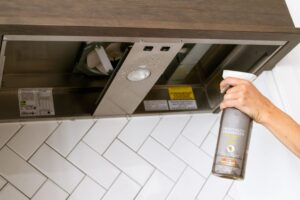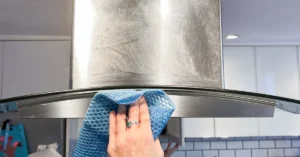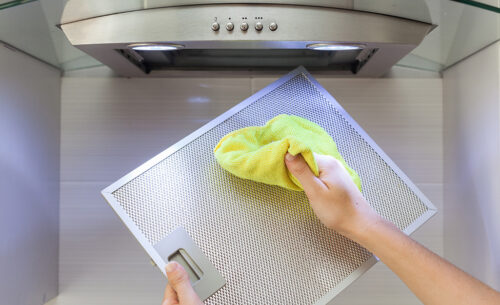Grease, smoke, and cooking fumes can turn your once-shiny range hood into a greasy mess over time. It’s one of those kitchen spots that quietly collects grime until you suddenly realize it’s due for attention. That’s where the question How do you clean range hood filters often comes up for anyone who wants to keep their kitchen fresh and efficient.
Understanding the process can make all the difference between a clogged, noisy fan and one that works effortlessly. A clean range hood not only keeps the air clear but also extends the life of your appliance, making it an essential part of regular kitchen care.
Understanding Range Hood Filters

Understanding range hood filters is essential for maintaining a clean, efficient, and healthy kitchen environment. These filters play a crucial role in trapping grease, smoke, steam, and cooking odors that are released into the air whenever you cook.
Without them, grease particles would settle on kitchen surfaces, appliances, and even walls, making cleaning difficult and potentially causing unpleasant odors or fire hazards. Essentially, the range hood filter is the heart of your ventilation system—it determines how effectively your hood can remove airborne contaminants and keep your kitchen fresh.
There are several types of range hood filters, each designed for specific functions. Mesh filters, commonly made from aluminum or stainless steel, consist of multiple fine layers that trap tiny grease particles as air passes through. They are lightweight, easy to remove, and can be washed regularly to maintain performance.
Baffle filters, on the other hand, are built with interlocking panels that force air to change direction quickly, causing grease to condense and collect in the filter. These are more durable, efficient, and often used in professional or heavy-duty kitchens. For ductless range hoods, charcoal filters are used in combination with mesh or baffle filters to absorb odors and smoke before the air is recirculated back into the kitchen.
Over time, all these filters accumulate grease and debris, which can block airflow and reduce the efficiency of your range hood. Dirty filters also cause the fan to work harder, increasing noise and energy consumption.
That’s why regular cleaning and maintenance are vital. Mesh and baffle filters should be cleaned every few weeks, depending on cooking frequency, while charcoal filters need to be replaced every few months since they can’t be washed. By understanding how each type of range hood filter works and caring for them properly, you ensure that your kitchen stays fresh, safe, and well-ventilated at all times.
How to Clean Range Hood Filters
Dirty range hood filters reduce airflow and become fire hazards. Below is a step-by-step guide to clean most common types (aluminum mesh, baffle, and charcoal/activated-carbon), plus maintenance tips and safety notes.
Before you start — materials & safety
- Turn off the hood and unplug it (or switch off circuit) for safety.
- Tools & supplies you may need: gloves, eye protection, a large basin/sink or bathtub, dish soap (degreasing type), baking soda, white vinegar (optional), nylon/brass scrub brush or old toothbrush, non-abrasive sponge, microfiber cloths, soft-bristle brush, bucket, paper towels, and a degreasing spray (optional).
- Identify filter type: aluminum mesh, stainless baffle, or charcoal/activated-carbon (usually boxed/capped — non-washable). Check your hood manual if unsure.
1) Remove the filter(s)
- Locate the latch, handle, or spring clips — most filters slide or drop out when you depress a clip or turn a small lever.
- Support the filter with one hand while releasing to avoid dropping oil/grease into the cooktop.
- Place removed filters on a paper towel-lined surface if you need to transport them to the sink.
2) Method A — Deep soak (best for aluminum mesh & very greasy baffle filters)
- Fill a large basin, sink, or bathtub with very hot water (as hot as safe for your plumbing).
- Add 1/4 cup (60 ml) concentrated degreasing dish soap and 1/4–1/2 cup (60–120 g) baking soda per large sink/tubful. (Baking soda helps lift grease.)
- Submerge filters fully and weigh them down so they stay underwater. Soak 15–30 minutes (longer for heavy buildup — up to 1 hour).
- After soaking, use a nylon/brass brush or scouring pad to scrub each side — pay attention to pleats and seams where grease hides.
- Rinse thoroughly with hot water until suds and residue are gone.
- Shake off excess water and pat dry with microfiber cloths, or allow to air-dry fully before reinstalling.
3) Method B — Dishwasher (if manufacturer allows)
- Check the user manual — some filters are dishwasher-safe, others are coated and will be damaged.
- Place filters upright in the dishwasher (not stacked) so water jets hit both sides.
- Use a heavy-duty or “pots & pans” cycle and a good dishwasher detergent.
- Inspect after cycle; stubborn grease may remain — follow with a quick hand scrub and rinse.
- Dry completely before reinstalling.
4) Method C — Stubborn grease / very old buildup
- Spray or apply a commercial degreaser formulated for kitchen grease (follow label safety instructions and ventilate).
- Let product sit briefly (as directed), then scrub with a brush. Avoid harsh abrasives that can damage finishes.
- For stubborn oily residue, alternate soaking in hot vinegar + water (1:1) for 15–20 minutes, then scrub and rinse.
- If metal filters have a smoky discoloration but are structurally sound, cleaning will improve performance though not necessarily restore original color.
5) Charcoal / activated-carbon filters (non-washable)
- These filters cannot be effectively cleaned — they absorb odors and grease.
- Replace according to manufacturer guidance (commonly every 3–12 months, depending on usage) or when you notice decreased odor capture / smell.
- Disposal: follow local waste guidelines.
6) Cleaning stainless baffle filters (specific tips)
- Baffle filters have channels that trap grease — they tolerate more aggressive cleaning.
- Soak with the same hot water + dish soap + baking soda mix, then hold under running water and brush along the baffles to dislodge grease.
- For very heavy build-up, a boil-in-water soak (if material and finish allow) or a commercial degreaser works — check manual first.
7) Drying & reinstalling
- Ensure filters are completely dry to avoid drips into the fan motor. Pat with cloth then air dry upright.
- Reinstall by reversing removal steps — make sure clips/latches engage securely.
- Plug the hood back in and run the fan briefly to check normal operation.
Regular cleaning restores airflow, reduces odors and fire risk, and keeps your hood efficient. For mesh/baffle filters, use a hot soak with dish soap + baking soda or a dishwasher if allowed; charcoal filters should be replaced. Clean on a schedule that matches your cooking habits and inspect filters visually — if in doubt, replace rather than risk performance loss.
How Often Should You Clean Range Hood Filters?

Keeping your range hood filters clean is one of the simplest yet most important steps to maintain a healthy and efficient kitchen. Range hood filters trap grease, smoke, and airborne particles that accumulate while cooking — and over time, these build-ups can block airflow, reduce performance, and even create unpleasant odors.
General Cleaning Frequency
For most households, range hood filters should be cleaned every one to three months. However, this depends on how frequently you cook and the type of food you prepare:
- Light cooking (1–2 times a week): Clean every 3 months.
- Moderate cooking (several times a week): Clean every 2 months.
- Heavy or daily cooking (especially frying or grilling): Clean once a month or even more often if you notice grease buildup.
Type of Filter Matters
- Metal Mesh or Baffle Filters: These are washable and should be cleaned regularly using warm water and degreasing soap.
- Charcoal Filters: Found in ductless range hoods, these cannot be washed. Instead, they should be replaced every 3 to 6 months, depending on usage and manufacturer recommendations.
Signs It’s Time to Clean
Even if you follow a schedule, some clues tell you it’s time for cleaning:
- The hood isn’t pulling smoke or steam effectively.
- There’s a sticky film or visible grease on the filter.
- You notice strange odors coming from the hood.
- The fan sounds louder than usual because it’s working harder.
Why Regular Cleaning Matters
Cleaning your range hood filters regularly:
- Improves air quality by effectively removing smoke and odors.
- Extends the lifespan of your range hood and motor.
- Reduces the risk of grease fires.
- Keeps your kitchen cleaner, preventing greasy residue from settling on cabinets and walls.
Quick Tip for Maintenance
If you cook frequently, do a visual check every few weeks. If you can see grease buildup, don’t wait for your calendar reminder — clean it immediately.
How often should you clean range hood filters? It truly depends on your cooking habits and filter type. But as a rule of thumb, monthly or bi-monthly cleaning keeps your range hood efficient, safe, and fresh. Regular maintenance not only ensures proper ventilation but also helps maintain a cleaner, healthier kitchen environment.
Tips for Easier Maintenance
Keeping your range hood filters clean doesn’t have to feel like a chore. With a few smart habits and simple tricks, you can make the process quicker and easier — ensuring your kitchen always stays fresh and your hood performs at its best.
- Wipe After Heavy Cooking
After frying or cooking oily meals, wipe down the range hood surface and edges with a damp cloth and mild dish soap. This prevents grease from hardening on the filters and surrounding areas.
- Soak Filters Regularly
Even if you don’t deep clean every month, soaking your filters in warm, soapy water for 10–15 minutes once a week helps loosen grease buildup and makes the next deep clean easier.
- Use Baking Soda and Vinegar
For stubborn grease, mix baking soda and white vinegar in hot water and soak your filters. This natural solution cuts through grease without harsh chemicals and helps maintain the metal’s shine.
- Avoid the Dishwasher if Not Recommended
Some filters are dishwasher-safe, but others aren’t. Check your manufacturer’s instructions first — the dishwasher can damage certain finishes or loosen the mesh if not designed for it.
- Set a Cleaning Reminder
Add a cleaning reminder to your phone or calendar every month or two. Consistency prevents buildup and keeps your filters easy to clean.
- Clean the Hood Interior Too
When you remove the filters, take a moment to wipe the inside of the range hood. This prevents grease from dripping onto freshly cleaned filters later.
- Use a Degreasing Spray
Invest in a good kitchen degreaser spray. Spraying the filters before soaking helps break down thick grease layers, cutting your cleaning time in half.
- Inspect and Replace When Needed
No matter how well you maintain them, some filters eventually wear out. If your filters are damaged, bent, or permanently discolored, replace them to ensure proper airflow and safety.
Maintaining your range hood filters becomes effortless when you build simple habits into your routine. Regular wiping, soaking, and timely reminders not only save you from tough scrubbing later but also keep your kitchen smelling clean and your ventilation system running smoothly.
Common Mistakes to Avoid

Cleaning your range hood filters is straightforward, but many people unknowingly make mistakes that can reduce the hood’s efficiency or even damage the filters. Avoiding these errors ensures your kitchen stays fresh, your filters last longer, and your hood performs properly.
- Waiting Too Long to Clean
One of the biggest mistakes is neglecting the filters until they’re completely clogged with grease. Dirty filters make your range hood work harder, increase energy use, and can even become a fire hazard. Clean them regularly instead of waiting for visible buildup.
- Using Harsh Chemicals
Strong chemicals or abrasive cleaners can corrode metal filters or damage protective coatings. Always stick to mild dish soap, baking soda, or vinegar solutions — they’re effective and safe for most filter types.
- Scrubbing Too Hard
Aggressive scrubbing with steel wool or rough brushes can warp the filter mesh or create holes. Use a soft brush or sponge to clean gently without damaging the surface.
- Not Rinsing Thoroughly
Leaving soap or degreaser residue on the filters can attract more dirt and make them sticky. Rinse thoroughly with warm water until no bubbles or residue remain before drying.
- Reinstalling Filters While Still Wet
Moisture trapped inside the hood can cause rust or mildew. Always let filters dry completely — either air-dry overnight or use a towel to speed it up — before reinstalling them.
- Ignoring Non-Washable Filters
Charcoal or carbon filters in ductless range hoods are not washable. Trying to clean them with water or soap ruins their ability to absorb odors. These filters must be replaced every few months as recommended.
- Forgetting to Clean the Hood Interior
Even if you clean the filters, grease can accumulate inside the hood and around the fan. Failing to clean these areas can cause unpleasant smells and reduce ventilation efficiency.
- Skipping Safety Checks
When removing or reinstalling filters, be careful not to damage electrical parts or light fixtures inside the hood. Always make sure the hood is turned off before cleaning.
Avoiding these common mistakes makes range hood filter maintenance safer, faster, and more effective. Gentle cleaning, regular upkeep, and proper drying go a long way in keeping your kitchen air clean and your ventilation system working efficiently.
When to Replace Range Hood Filters
Even with regular cleaning, range hood filters don’t last forever. Over time, grease, smoke, and residue can build up beyond what cleaning can fix — and that’s when replacement becomes necessary. Knowing when to replace your range hood filters helps keep your kitchen air fresh and your ventilation system efficient.
- Metal Mesh or Baffle Filters
These filters are usually washable and reusable, but they still wear out after years of use. You should replace them when:
- The mesh is damaged, bent, or torn, reducing airflow.
- Grease buildup remains even after thorough cleaning.
- The filter looks discolored or dull, showing signs of corrosion or age.
On average, replace metal filters every 1 to 3 years, depending on how often you cook and how well you maintain them.
- Charcoal or Carbon Filters
Charcoal filters are non-washable and are mainly used in ductless range hoods to trap odors and smoke. Over time, they lose their ability to absorb smells. Replace them when:
- You notice persistent cooking odors even after cleaning.
- The hood’s performance decreases or airflow weakens.
Manufacturers typically recommend replacing charcoal filters every 3 to 6 months, depending on cooking frequency.
- Signs You Need Replacement (Any Type)
Regardless of filter type, watch out for these universal signs:
- The kitchen air feels smoky or greasy after cooking.
- The fan sounds louder or struggles to pull in air.
- Visible grease stains or burnt spots remain after cleaning.
- A strong, unpleasant odor persists even after washing.
- Maintenance Tip
Keep a replacement schedule — mark your calendar or set a reminder when you last cleaned or replaced filters. Doing this ensures you never forget to swap them at the right time.
Knowing when to replace range hood filters is key to maintaining clean air and proper ventilation in your kitchen. Metal filters can last for years with care, while charcoal filters require frequent replacement. By paying attention to performance changes and visible wear, you’ll ensure your range hood continues to work efficiently and safely.
Conclusion
Keeping your kitchen fresh and efficient depends greatly on how well you maintain your range hood. Understanding the importance of this simple task ensures your cooking space stays clean and free from unwanted odors. The question, How do you clean range hood filters, goes beyond a routine chore—it’s about preserving the heart of your kitchen’s air quality.
In the end, consistent care and timely maintenance go a long way in extending your appliance’s lifespan. A clean range hood not only improves performance but also enhances your overall cooking experience, making your kitchen a healthier and more pleasant place to be.

